
38 minute read
Identity and Togetherness
URBAN VILLAGE
Urban Village has the impressive distinction of being the first South African band to sign with respected French label Nø Førmat! The Soweto-based foursome was discovered by former A&R manager Thibaut Mullings, who took an interest in the band after relocating to Johannesburg. “We kept seeing him [Mullings] at our shows,” explains drummer Xolani Mtshali. Then, one night, during a show in Alexandra, a township of Johannesburg, Mullings appeared with label founder Laurent Bizot – also now Joburg-based – in tow.
“The love and excitement Laurent and Thibaut have shown for our music assures us that they are the best partners to release our debut album,” explains Mtshali. “They have given us the chance to create an album that can reach a global audience, whilst remaining true to our Soweto roots.”
Udondolo, a Zulu word meaning “walking stick”, is just so: an album shaped as much by the nation’s often troubled past, as it is by a more hopeful present. It’s a nimble, melodic and culturally conscious offering, a record bound by a belief in “ubuntu” or “common humanity” – the same byword that drove anti-apartheid revolutionaries such as Nelson Mandela and Steve Biko. Songs about struggles and joys, identity and togetherness abound, couched in tempos and melodies that owe as much to the rural, traditional, indigenous Zulu music (Isicathamiya) played on the streets of Soweto by their older neighbours, as to the more modern, multicultural sounds.
The music feels surprisingly fulsome given a relatively simple set-up: vocals, bass, percussion and guitar, gilded lightly in places with touches of cello, brass, lap steel, mbira and flute. That last instrument, played with dexterous elegance by vocalist Tubatsi Mpho Moloi, is an uncommon choice for a modern South African musician. “In the beginning, I was really interested in learning to play the saxophone, but I had no access to one.” As luck would have it, Urban Village guitarist Lerato Ntsane Lchiba happened to have a sax at his disposal, but when Moloi came across a flute six years ago, he swiftly changed course. “I’ve been making it part of the Urban Village sound ever since that moment.”
Udondolo is a pleasingly varied album, ranging from jubilant, bubbling party-starters such as Dindi – a standout celebration of Black pride – and Marabi – a joyfully self-aware medley of familiar South African standards. Then, there's the quieter, introspective numbers like Ubaba, a meditation on fatherhood, and Madume, an evocative ode to a rural greeting practiced in cities and villages alike across Africa.
Playing in South Africa is somewhat tricky, says Mtshali. “Most of the live music venues we have here are being closed down, whilst those remaining do not have the standard backline which makes it financially difficult.” Besides, says Mtshali, the band feel most at home with “the backyard sessions – places that enable us to be free from the concrete jungle.” “Udondolo is a pleasingly varied album, ranging from jubilant, bubbly party-starters to the quieter, introspective numbers and evocative odes to rural greetings practiced in cities and villages alike.”
Words Charlotte R-A
KEMI ADE
Kemi Ade was eight years old when she first performed in front of an audience. “I was in Year Four, singing a Christmas carol solo, from Silent Night. I felt a rush that was nothing like I’d ever felt before. That feeling has and will always be my favourite thing.” It has been a hot minute since those school assembly days, of course, but Ade is still chasing that feeling. She’s a promising young voice, a London-born singer of Nigerian descent dealing in mellifluous, neo soulinspired R&B. Ade credits the likes of Musiq Soulchild, Jill Scott and Erykah Badu for helping her to “find some of the things my voice could do.” There’s certainly a strong throwback vibe – lush, rich styling concerned with pleasure and romance – but like any artist worth her salt, Ade’s gazing forward as much as she is backwards. That much is clear.
You’d be hard-pressed to guess it from her Americanaccented vocals, but Ade grew up in Croydon. Her parents passed on a love of music and consistently encouraged her artistic vocation, but Ade didn’t begin recording until her time at Bucks New University in High Wycombe, where she studied Music Management and Studio Production. Her latest EP, Drive (Dusk Edition), marks her third release, following O.W.Nesty in 2017 and Drive (Dawn Edition) last October.
When it comes to penning her songs, she’s most likely to be found “in a forest,” basking in the space and sounds that these quiet refuges afford. Hampstead Heath is one of her favourite haunts, but her go-to green space is the woodland behind her home; it’s a quiet, isolated spot, one where the view allows you to watch the sun rise and set, uninterrupted.
As the UK sits firmly within its third Covid lockdown, many of us are renewing our love of nature. We’re also turning to the arts for comfort, delving into escapist pleasures. Ade’s used lockdown to read (mostly YA fantasy, always in print format “because I like the smell”), paint (“acrylics are my go-to”) and sketch. She has also been moonlighting of late, writing songs for fellow fledgling artists such as Rebecca Garton and BSHP. Whilst she dreams of collaborating with the likes of Dua Lipa, she still considers herself something of a lone ranger. Though she’s determined to carve out a place for herself here in the UK, she’s savvy to the limitations Black female artists face when navigating the British music industry. “In the UK, we’re [historically] restricted. The industry’s always pushing a certain mould, one type of voice and sound. Anything different is always met with resistance. The USA gives Black womxn space to freely express their art. It’s so big there that [the industry] has no choice but to be diverse; different states produce different sounds. The UK is so small in comparison.” It’s an argument that has parallels in the acting world, with recent, high profile debates on the idea that Black British actors often need to move to find success. Would Ade relocate? In a heartbeat, she says. “In the UK, we're [historically] restricted. The industry's always pushing a certain mould, one type of voice and sound. Anything different is always met with resistance.”
Words Charlotte R-A
soundcloud.com/kemiade


Towards the Sun
MODERNIST ESCAPES
The idea of an architectural escape, nestled away from viruses and national lockdowns, has never seemed more appealing with everything that’s going on in the world. For many of us, the prospect of a prolonged adventure feels like a pipedream, but if there’s anything that can shake us out of our cabin feverish minds, it’s Stefi Orazi’s Modernist Escapes. This new book offers a sleek and insightful guide – as with Orazi’s previous works including Modernist Estates and The Barbican Estate – to some of the movement’s most significant structures from across the world, all of which are open to the public. From the works of Alvar Aalto to Charlie Zehnder, Oscar Niemeyer to Walter Gropius, each building is unique in its approach and thrilling to look at, accompanied by informative texts offering insights into structural history.
“The general principles of modernism, such as large areas of glazing, orientation towards the sun, and a connection between the inside and the outdoors, are demonstrated in many of the featured examples featured,” says Orazi, who describes coming up with the concept for the publication after visiting Le Corbusier’s Convent of La Tourette – a Dominican monastery with tiny rooms (or “cells”), each equipped with just a desk, single bed and Charlotte Perriand-designed spacesaving cabinet. “When I returned, a friend told me of Marcel Breuer’s Flaine, a jaw-dropping, cliff-hanging ski resort in France, and there began the idea to compile the structures.”
Orazi highlights the far-reaching and diverse impact of modernism. There’s Brazilian visionary Niemeyer’s geometric designs for the Hansaviertel neighbourhood in Germany, and Moscow-based architect Konstantin Melnikov’s eponymous Melnikov House, inspired by American silos and Russian churches. Meanwhile, Ernő Goldfinger’s 2 Willow Road in London is one of the earliest modernist houses in the UK, and the Gropius House evokes the efficiency of the Bauhaus.
Some of the structures have survived against the odds, whether it’s “the takeover of the Bauhaus by the Nazis during the WWII or the seizing of the opulent, Loos-designed Villa Müller by the communist government of Czechoslovakia.”
Others, like Frank Lloyd Wright’s Fallingwater, characterised by floating rectangular planes that cantilever out from a cliff face, and the organic forms of George Nakashima’s studio and workshop, are individual homes at one with nature. “Wright said that ‘The good building makes the landscape more beautiful than it was before the building was built’, making the two aspects inseparable in any composition. He sought to merge the landscape with the architecture, so it is both a structure and a form of ornamentation.”
Whether you’re looking for a much-needed respite from the daily slog of pandemic living and working, or you’re planning your next (government mandated) holiday experience, Modernist Escapes will leave you pining for better days. “The general principles of modernism, such as large areas of glazing, orientation towards the sun, and a connection between the inside and the outdoors, are demonstrated in many of the examples featured here.”
Words Gunseli Yalcinkaya
Subverting the Hierarchy
RAISING THE ROOF
Back in 2018, The New York Times published an article titled Where Are All the Female Architects? Nearly half of architecture students are women, it read, yet they only represent 20 percent of licensed architects. “The history of architecture, as in many other disciplines, has been largely written by men. Women have been mostly marginalised or ignored,” says Agata Toromanoff, author of Raising the Roof: Women Architects Who Broke hrough the Glass Ceiling.
The book features 50 designers, from practitioners with well-established careers – who run their own studios or are equal partners – to young, emerging professionals. There’s Elizabeth Diller, the mastermind behind New York’s The
High Line and a key figure in the redesign of The Museum of Modern Art, and Tatiana Bilbao, who is leading the way in sustainable Mexican architecture; Nigerian “starchitect” Olajumoke Adenowo and Neri&Hu’s Rossana Hu.
Whilst “the aim of this book is definitely not to create a parallel, ‘feminine part of the story’,” it spotlights many women that have been erased from architectural discourse. Amongst them is Denise Scott Brown, a postmodern pioneer and the visionary behind the seminal text, Learning From Las Vegas. “The Las Vegas case study is considered a quintessential example of the postmodern way of thinking, which, just as revolutionary in its time, caused many controversies and heated debate,” explains Toromanoff, referring to the essay that outlined the many freakish architectural mini-movements that emerged on the Vegas Strip in the 1970s. Scott Brown also coined the term “duck” to refer to buildings that act as sculptural, symbolic objects (in reference to a duck-shaped eggstand on Long Island), but her work was largely snubbed in favour of her partner, the late Robert Venturi.
In addition to still-active professionals, there are also portraits of late figures like Gae Aulenti, Lina Bo Bardi, Eileen Gray and Zaha Hadid. “Any picture would be incomplete without them,” says Toromanoff. Irish-born Eileen Gray – behind the infamous adjustable E 1027 Table – was one of the first women admitted to the Slade School of Art, before pursuing a career in architecture – a decision spurred on by friend and close collaborator Le Corbusier. Bo Bardi, who worked with the likes of Carlo Pagani and Gio Ponti, was known for radical forms, daring constructions and playful compositions.
Change is happening slowly but surely. Last year, Grafton Architects co-founders Yvonne Farrell and Shelley McNamara won the Pritzker Prize, making them the fourth and fifth female recipients in the award’s 41-year history. Feminist collective Rebel Architette has created the Women Architects World Map as a tool to “detox” architecture from its “boys club” mentality, whilst a record number of female deans are opening doors and providing platforms for women. Raising the Roof pulls back the institutionalised curtain. Words Gunseli Yalcinkaya
prestel.com


1Mother KRISTOF BILSEN
A documentary with two very distinct but interrelated storylines, Kristof Bilsen’s Mother is a rich portrait of family, sacrifice and hope. Set in Thailand, in Chiang Mai, it centres on Baan Kamlangchay, a care centre for Alzheimer patients from the west. Each of the patients receives 24/7 attention from three caregivers – whether it’s accompanying them to buy clothing or going on walks.
Initially, the focus is Pomm, a young woman who has left her own children in the care of others in rural Thailand, some six hours from Chiang Mai, so she can work and support her family. As painful as this is, she clearly derives huge satisfaction from helping patients; this is not just about nursing but providing emotional nourishment when they’re becoming dependent on others.
Bilsen’s observational film switches from hot and clammy Thailand to the crispy, snowy environs of Switzerland, where we meet Maya, a woman in her 50s who is suffering from Alzheimer’s. Her husband and three daughters have made the painful decision to take her to Baan Kamlangchay, where she will spend the remainder of her days in the care of Pomm and others. “Many people don’t understand that we are not disposing of her,” says one of her offspring, inquisitively.
Bilsen’s camera follows Maya’s journey to Thailand with her family, as she settles in and they must say their goodbyes. A later Skype call between Maya and her husband, where she vacantly stares at the screen unable to recognise him, shows just how devastating the disease can be. Yet this is more than just a film about the impact of Alzheimer’s. As the title suggests, it’s really about the bond between a mother and her children – unshakable even in the most trying of circumstances. Words James Mottram
paramount.com
2Gunda VICTOR KOSSAKOVSKY
After watching Victor Kossakovsky’s Gunda, director Paul Thomas Anderson (Boogie Nights, Magnolia) described the documentary as an example of “pure cinema.” Praise like that can sometimes feel perfunctory but, in this instance, it’s an almost perfect description. There is something “pure” about the way Gunda handles its subject, with its distilled narrative, and a tight focus on a cast of farmyard animals – a pig, chickens and cows.
Each shot has a habit of lingering over its subject but each one is necessary; nothing in this film feels extraneous. As we move from animal to animal, very little happens. The film begins to resemble a study or a series of distinctive portraits. We observe these creatures’ movements, their behaviour, and it’s difficult sometimes not to endow the creatures with human traits or qualities. The pace remains patient and steady throughout, which affords us time to appreciate the lives before us. We spend a lot of time looking at animals looking back.
Yet, what’s surprising is just how deeply entrancing Kossakovsky's film is: the longer you watch, the more difficult it becomes to tear yourself away from these characters. And that’s because Gunda turns out to be more than a spectacle: it’s an experience in animal bonding. It forces us to reconsider the ways in which we think about what we refer to as “livestock.”
Our greatest attachment is formed with a sow – the eponymous Gunda – and her litter of piglets. We see the intense labour involved in rearing and caring for her offspring: there is endless feeding and constant shepherding, as well as consuming worry, but also a radiating sense of content and joy. But Babe, this is not; slowly, the absence of external realities becomes more conspicuous. Words Chris Webb
gunda.movie
3Robin's Wish TYLOR NORWOOD
A documentary about the final, tragic years in the life of one of America’s greatest comic talents, Robin’s Wish is a stark reminder of just who the world lost on 11 August 2014. Robin Williams, who starred in such films as Good Morning, Vietnam and Dead Poets Society, took his own life that day, but this was not just another case of a depressed comedian tipped over the edge.
Williams’ ordeal came from Lewy body dementia, a particularly brutal form of the disease that gradually attacks the brain. By the end, Williams was left feeling that he was no longer the person he once was, unable even to remember lines. For a man who spent his entire life entertaining the world – who took joy from bringing laughter to others – it was a cruel way to go.
Worse still: Williams’ affliction was only diagnosed after he’d died, meaning his final months before were ones of confusion and desperation. Director Tylor Norwood talks to many people close to Williams, including his widow Susan Schneider Williams, who bravely faces the cameras to unpick what is obviously a hugely painful subject.
Others who contribute include comedian pal Mort Sahl, Lewy Body expert Dr Bruce Miller and Shawn Levy, the director of the Night at the Museum films, who reveals just how disoriented Williams was during the 2014 Vancouver shoot for the third of those movies – something the cast and crew all kept hidden from the press and public.
Avoiding the celebrity bio approach – there’s no mention, for example, of Williams’ sitcom breakout Mork & Mindy or his Oscar win for Good Will Hunting – Norwood instead paints a picture of Williams away from the spotlight. Highlighting his work entertaining the US troops, for example, it’s a testament to a generous, gifted soul. Words James Mottram

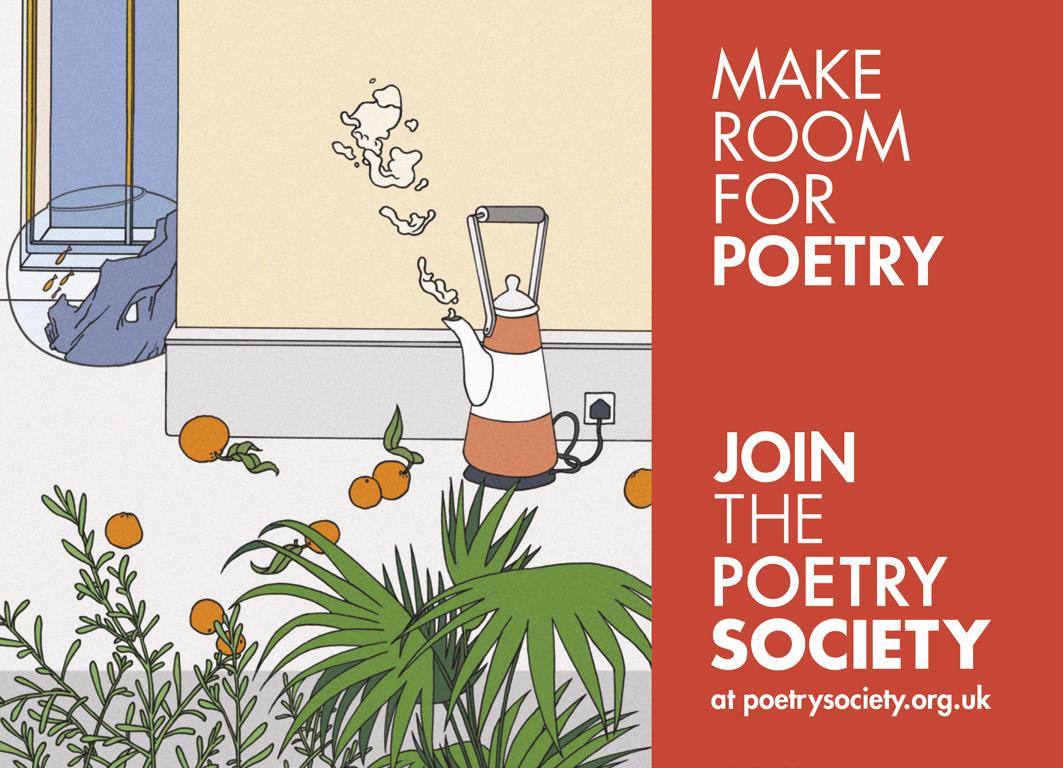
1Trial & Error AMIRALI
Eclectic Iranian producer Amirali returns with his sophomore release packed with bleeping electronic, transcendent pop, and artisanal soundscapes. Perfected at the legendary Abbey Road studios, each song packs the drama you would expect that comes from such a momentous birthplace. Neo-classical Blade Runner aesthetics meet tinkering piano lines, constantly teetering on the edge emotion-inducing sound design. It's as if we, as listeners, are attendees to a conceptual art exhibition.
Moments of bright sparks and ethereal melodic promise raise the record up from seeming too deep, dark and digital, such as the stepping-down minor notes of Dry Cry which are beautifully woven into Amirali’s sparse vocals. Overall, this detailed and painstakingly conceived project suffers the most when it is too laden with pre-set sounds, drums and over processed synthesizers, taking away from the real and honest warm of the ideas behind it. This is shown harshly on Vertigo, where strong songwriting would have been galvanised by more organic musical attention. The glitchy A Fly In Your Tongue is equal parts the extravagant, floating outros of Kanye West, as it is over-produced drum and bass.
The elegance of A Thousand Ways To Die provide Little Dragon tones, meeting industrial jump-up, trippy programming. The waves of off-kilter and at points random electronic sounds give the project as a whole a non-linear and wavily detailed feel. Meanwhile, album highlight Shallow Grief is an affecting and powerful piano and strings-led composition – equal parts glitchy and wholesome. The piece moves in a wild direction. Deep diving into his even more experimental side, it will be exciting to see what Amirali has in store next. Words Kyle Bryony

amirali.bandcamp.com
2All the Unknown GRANDBROTHERS
From the outset, All the Unknown is an exploration of compositional possibilities for pianist Erol Sarp and producer/electronic engineer Lukas Vogel, who met almost a decade ago whilst studying audio and video engineering in Düsseldorf. Their debut album Dilation, released in 2015, was followed by the majestic Open in 2017, a contorted hybrid of electronica and classical piano. These days, with the pair no longer both residing in Düsseldorf, they have discovered a new remote way of working that lends itself to greater experimentation and a metamorphosis into techno and hip-hop influenced beats, building layer upon layer of electronic sounds.
Album opener Howth and the compelling title track each begin with emotive piano, which subsequently gives way to rich, intense electronica and digital percussion. Elsewhere, What We See moves freely with a buoyant fluidity and Four Rivers rushes by in seemingly no time at all before succumbing to melancholic piano, fading into reverb as it closes. The high-octane Organism is a more straightforward track referencing early 1990s clubs.
On the hip-hop-flavoured Mourning Express, the duo used a tape recorder to create vintage sounds. It is these tiny aural fragments that make this track particularly affecting. All of the samples are collected using mechanics built by Vogel, then extracted, processed and shaped beyond their original identity. Melding this with organic piano gives Grandbrothers its distinct sound.
All The Unknown frequently moves between bright and inspired highs to melancholic and reflective lows. Continually driven forward by electronic beats and ambient sounds that encourage movement, the album is diverse ultimately bound by a sense of positivity and hope. Words Matt Swain

grandbrothersmusic.com
3Try Harder AERIAL EAST
West Texas-raised and New York-residing, Aerial East delivers an extremely intimate new album documenting a transient lifestyle filled with all of the expected, and annoyingly inevitable, obstacles. Littered with beautifully melancholic references to heartbreak – both literal and more spaciously metaphorical – this delicately orchestrated project is a meditative experience to behold. Performing in a piercing Kate Bush pitch, East reaches the former’s charisma and charm, feeling at points more like Lana del Rey but less over-produced.
Entirely non-manufactured, but still country twanged sad pop, on The Things We Build East croons through introspection and throws narratives over minimal southern-inspired tones. Calm and peaceful, it is easy to have the album on repeat without realising. Meandering ballads such as Ryan is a low mood ode to missing someone from a bygone era. The notably titled I Love Dick is in-fact sombre and close, tear-inducing and floaty – something akin to the Jon Brion original film score for Michel Gondry's Eternal Sunshine of the Spotless Mind.
Placed in the middle of this fantastic album is the folky San Angelo, in which the artist poetically describes her story through distant wails. On Blue she speaks of the hardships of moving on from old love when it still echoes and haunts one’s heart. It is impossible to not to clutch your chest and feel deeply empathetic from the tragic nature of how East sings, with each song picking up where the previous Tom Waits style heart string pulling left off. The creeping slow chords of the closer Be Leavin underscore Aerial East’s flittering emotive state and end what is without a doubt a luxurious and thoroughly fulfilling ride through the depths of sadness. Words Kyle Bryony



Photographer Matt Stuart (b. 1974) is always on the lookout for pictures. Never leaving the house without a camera, he is drawn to remarkable scenes – conjuring a strange and alluring world of giant peacocks, kerbside red devils and aliens on the London Underground. Whilst these subjects seem surreal – the stuff of manipulation, editing or montage – Stuart is very much a street photographer. Time and again, he finds intriguing compositions and juxtapositions within the everyday. “Some things that life offers are far more interesting or revealing than anything you can make up,” he explains in Think Like a Street Photographer. The images are a testament to how fascinating the world can be when we stop and look. Stuart’s volume is more than a photobook; it is an essential guide to the genre, laying out tips and tricks for budding image-makers to get the most out of the city. Alongside informative chapters on ethics, approach and mindset, Stuart offers a handful of key pointers to try when out and about. Advice ranges from the value of saying “yes” to observing the world from a child’s perspective. “Be open to everything when you’re out shooting,” he says. “If your eye is ‘on’, the pictures will come and the little curiosities that life throws up will suddenly appear everywhere for the taking.” Readers will, amongst other things, learn about Stuart’s most memorable shots and happiest accidents – where spontaneity reigns.
Most of all, Think Like a Street Photographer is an accessible read: bright, bold and concise with minimal focus on the technicalities. Instead, emphasis is placed on ways to see, observe and document our surroundings. To this end, Stuart quotes Elliott Erwitt: “All the technique in the world doesn’t compensate for the inability to notice.” Words Eleanor Sutherland
laurenceking.com
2Cherry Hill: A Childhood Reimagined JONA FRANK
Jona Frank, a photographer celebrated for capturing youth culture, turns the lens on herself in Cherry Hill. Part memoir, part photographic reconstruction, Frank’s book reads like a coming-of-age film in New Jersey. The writing is dramatised in playful, sometimes surreal, mise en scènes of the Frank family from 1952 until Jona leaves home in 1990. It’s a familiar but true story, almost out of Hollywood: a Catholic schoolgirl conforms then rebels. There’s disapproval, drugs and schizophrenia.
Frank’s staged photographs draw on old images and moments from the artist’s life. They boast elaborately awful wallpaper, recreated sets that should never have left the 1970s, and a credits page to make your eyes pop. Highlights include two “house explosion” specialists, a “toile wallpaper” consultant, and Oscar-winning actor Laura Dern, who steals the show as Rose Frank, Jona’s mother: a depressive housewife with a penchant for the silent treatment. Dern’s casting is a masterstroke and no doubt a nod to her role in Blue Velvet (1986), David Lynch’s suburban horror. When Rose isn’t wearing rose-patterned dresses, she matches the wallpaper. The implication is clear: she is the household. Her dead-eyed smile will have you checking the lawn for body parts.
As an art object, Cherry Hill is unsubtle and gawky. Frank mashes the scrawling Crayola of a child’s scrapbook (think Tim Burton or The Stepford Wives) of a half-remembered family album. There’s a disturbing, air-brushed quality to the images that signals we’re operating with a plastic, fictionalised reality. The production is repulsive, confused and often ugly – like growing pains for the eyes, or puberty. But for all its clichés about “flowering”, this is indeed the road to adulthood. Words Jack Solloway
monacellipress.com
3Keith Haring SIMON DOONAN
Simon Doonan (Creative Director at Barneys New York) provides a whistle-stop biography of Keith Haring (1958-1990), celebrating an artist who embraced radical queer joy, pop culture glamour and psychedelic fantasy in the face of the unfolding AIDS tragedy.
Haring’s small-town origins might explain the unfettered glee with which he took to Manhattan party life on his relocation to New York at the end of the 1970s. Meanwhile, a Warhol-esque ability for self-publicity was clear, as was an aversion to conventional fine-art career trajectories. Buoyed by the splash he was making through events and exhibitions at Club 57 – an anarchic art-space in the East Village – he dropped out of school and began creating street art in through the nowrecognisable bold, cartoonish idiom. Gyrating bodies interlock with spaceships, babies, dogs and pseudowritten symbols. Soon, Haring was plugged into New York’s burgeoning graffiti art scene, connecting its raw, garish energy to early artistic influences: Warhol, Jean Dubuffet and colourful shapes from TV cartoons.
It was when Haring started creating murals on the black panels of the Manhattan subway system that he began to blossom into what Doonan calls “a thing.” Within a stunningly short period of time Haring had graduated from iconic underground shows to prestigious international commissions and a dazzling celebrity lifestyle. Warhol stood by – a mentor and friend.
Doonan doesn’t downplay Haring’s love of celebrity. By contrast, he makes it seem heroic, an embrace of life in defiance of the virus that killed him in 1990. Today, Haring’s influence can still be felt everywhere: he remains, as Doonan concludes, unquestionably “groovy.” Words Greg Thomas



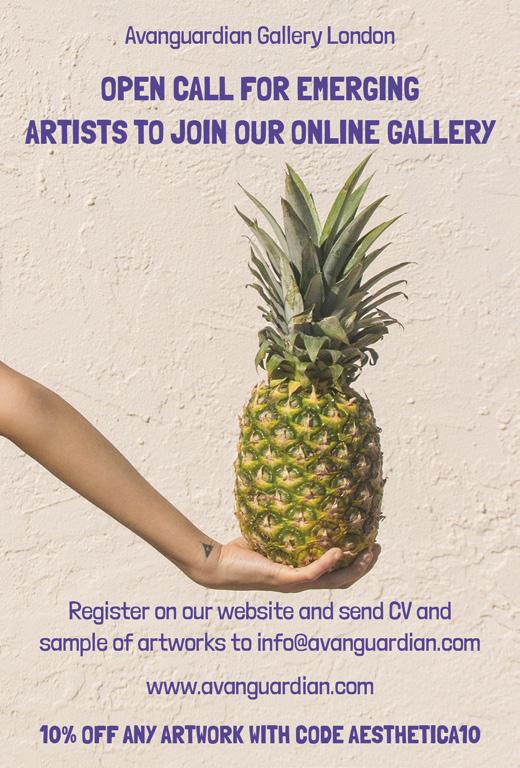


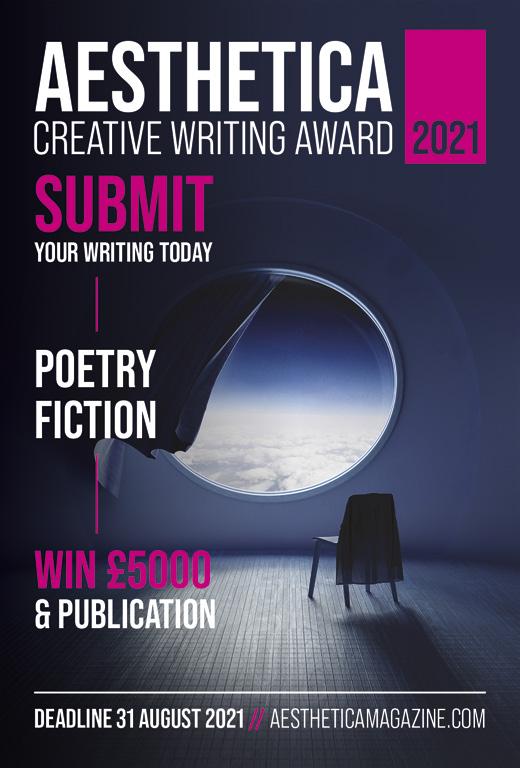
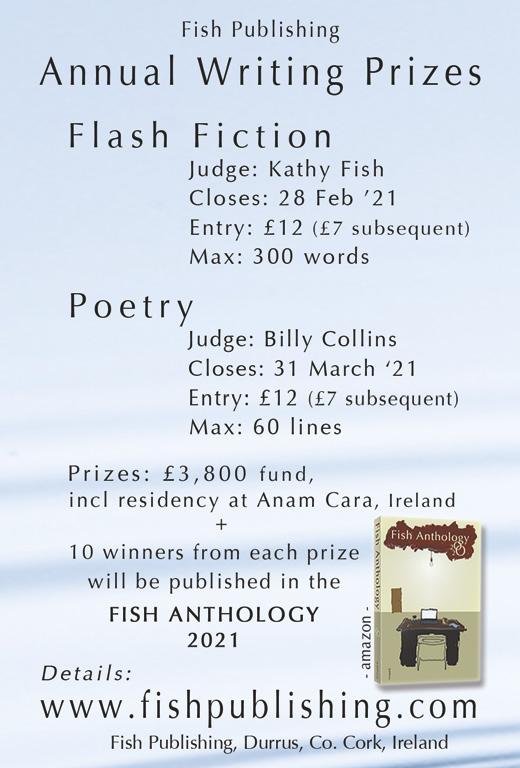

The Destination for Art and Culture
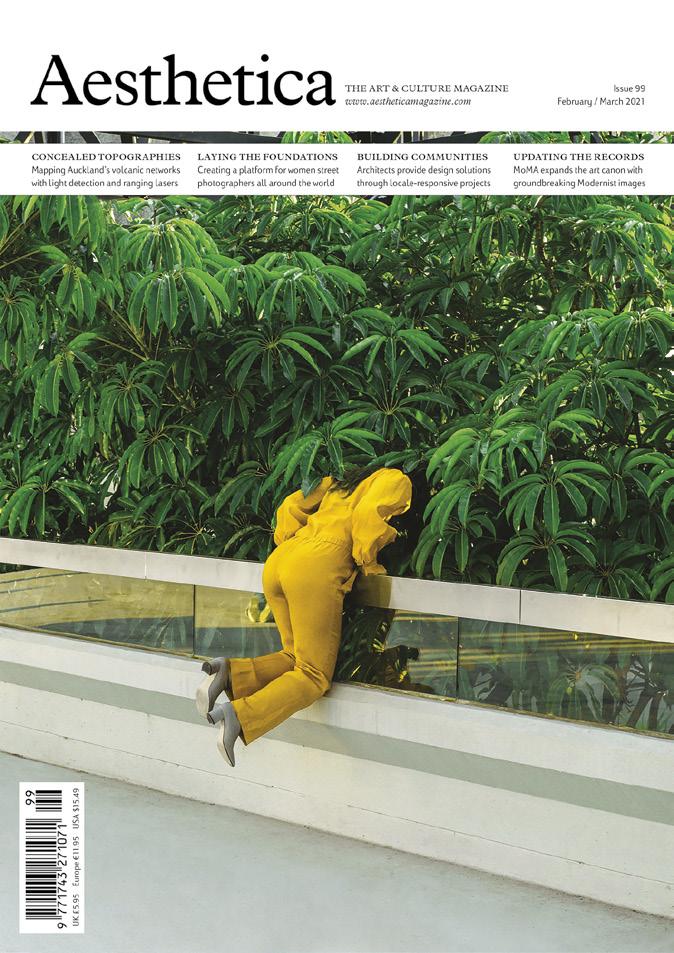
Subscribe & Save 40%
12 months from £20.95 + p&p. Available in both print and digital formats. www.aestheticamagazine.com/subscribe

NICOLETTA CERASOMMA

Nicoletta Cerasomma is an Italian pop surrealist photographer. In her series Mind Pop, she aims to “dig into the loneliness of being in a relationship, mostly when it is essentially at an endpoint. The burden she bears, like a suitcase full of happy memories, prevents her leaving. She stays, hidden under a surface of normality, where everything appears full of life and joy.”
nicolettacerasomma.it I Instagram: @nicolettacerasomma
MIROSLAVO

Miroslavo is a Czech painter based in Barcelona. A varied background drives him to explore new techniques, colour combinations and tools in the creation of highly expressive canvasses, each offering a bold point of view, such as the self-portrait presented here. The abstract paintings channel a vision that revolves primarily around human nature and innovation.
www.miroslavo.com | Instagram: @miroslavocom

MARTIN VEIGL
Martin Veigl is an award-winning Austrian artist. His numerous compositions offer collaged portraits with an intuitive blend of colours and forms; a complementary palette draws attention to anonymous figures as they are caught in states of transition. Veigl has exhibited widely and his current solo show is at Schnitzler Lindsberger Galerie, Graz until 5 March.
www.martinveigl.at I Instagram: @martin_veigl



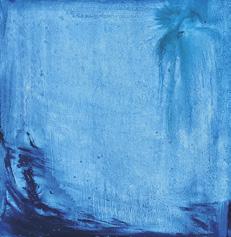
NATALYA BURGOS
Natalya Burgos is based in the Texas countryside, where she is inspired by the surrounding fields, trees and a distant horizon of land and sea. Her abstract paintings often feature blue as the predominant colour, as aptly demonstrated in the latest series Sky and Waves. Here the use of oil on canvas allows freedom for further experimentation with texture and light. These compositions display deeply personal portrayals of nature, moving us to confront the inner shackles that bind us to one another.
www.natalyaburgos.com I Instagram: @natalyaburgos_art

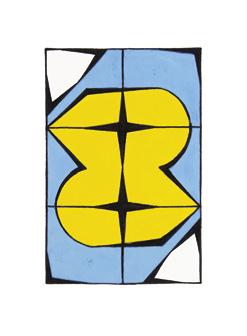
brendon Marczan

Brendon Marczan is a painter and illustrator based in London. Many of his artworks feature a tipi symbol – a nod to the traditional dwellings of some Indigenous Canadians and Native Americans. These triangular shapes represent shelter, safety and home. The tight patterns throughout Marczan’s work further reinforce a sense of community in fractured times. www.brendonmarczan.com I Instagram: @brendonmarczan
Diego Rey

Barcelona-based Diego Rey is an award-winning multidisciplinary artist. The series Rizomas en mi taller was created during confinement and "deals with scenes of natural objects from the sea in a space like my workshop, generating an atmosphere that seeks to explore ways in which our lives are transformed." Rey is currently part of the Ferran Adrià team at the elBulliFoundation. www.itinerariaexposiciones.com I IG: @drey_vacios

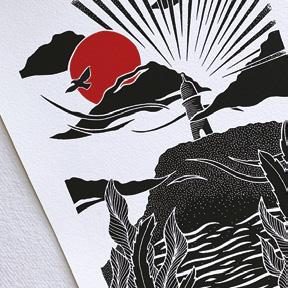
Chromakane
Chromakane is a London-based print studio founded in 2020 by Jessie Cohen, who has expanded her illustration ideas into the worlds of print, textile and tattoo art. Inspired by myths and the natural world, Cohen merges eastern and western storytelling with an abstract, blackwork aesthetic. Each piece begins as a pen and ink drawing before being reproduced to archival quality. www.chromakane.com I IG: @chromakane

Gunilla daga
Gunilla Daga is painter based in Stockholm who produces artworks which, in John Austin’s words, “are connected to each other, each image being born from the previous and forming a series of works where the artist investigates not only the nature of the materials at hand but seems to push each shape to take different forms." Daga has exhibited work throughout Europe and the USA. www.gunilladaga.se I IG: @gunilladaga
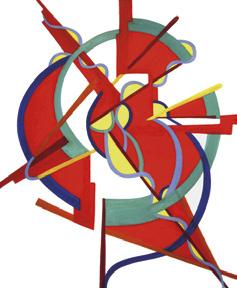

Jenny Williams
Jenny Williams is a UK-based painter with a background in visual merchandising and a love of music and dance. She finds that working primarily with oil paint allows for exploration of vibrant colour, texture and movement, as seen in her figurative works, landscapes and abstracts. In addition to her personal practice, Williams is also Chair of Herefordshire Art and Craft Society (HACS). www.jennywilliams.net

judie long
New York-based photographer Judie Long demonstrates a love for her subject matter as well as the action of creation. Scenes are captured with an eye for what she believes the viewer will appeciate seeing every day; the use of vivid colours and bold black and white are key in creating the artworks. Long's images are purchased as museum-quality framed works or ready-to-frame paper prints. www.judielong.com I IG: @ajudieoriginal
Karsten Thormaehlen
Karsten Thormaehlen is a Frankfurt-based photographer whose practice includes reportage and urban architecture, as well as portraiture, for which he has won numerous awards. Thormaehlen's latest project is Not Another Second, in which he creates striking images of LGBT+ seniors. An exhibition is underway at The Watermark at Brooklyn Heights until 31 March. www.karstenthormaehlen.com I IG: @thormaehlen_photography
kumi oda

Kumi Oda is a Japanese moving image artist and designer; she holds an MA in Information Experience Design from the Royal College of Art. Her works depict the life of insects in contrast with architecture to tell stories of large-scale social and environmental issues. Each film is carefully crafted with dexterity, using aesthetics as a tool to engage the viewer with chosen themes. www.vimeo.com/kumioda
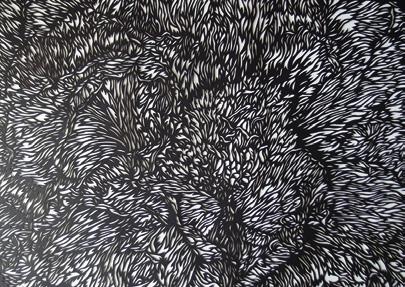
KIYORA
Kiyora is an award-winning, Tokyo-based artist with a background in architecture. Her intricate paper cutting works aim to depict the changing pockets of energy that make up our universe. Through bold, patterned contradiction, the compositions express light and dark, movement and stillness – using paper as a plane of representation and an outlet for creative expression. http://kiyora888.mods.jp I Instagram: @kiyora888

Manuel Caicoya
Manuel Caicoya is a Spanish architect and artist currently based in London. Extensive travels, living in various countries and interacting with other artists have driven him to the belief that art is a universal language. Caicoya's investigation of new forms and techniques in painting and photography means that any surface or object is a potential new canvas for expression. www.art-caiman.com I Instagram: @art_caiman



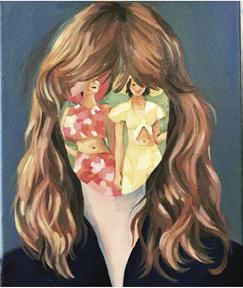
meta solar
Meta Solar is a Slovenia-based painter who explores representations of contemporary young women. She creates images with fluid meanings where portraiture, patterns and spaces play with the idea of the real – where figures mingle with abstraction. Bold lines and colourful brushstrokes show how the body and mind can be revealed in new ways. www.metasolar.si I Instagram: @metapasteta
Misa Sawairi
Misa Sawairi is a New York-based Japanese spatial artist and designer. The ongoing series Ripple Trip utilises urban streets as a canvas where she finds and records materials. Each expression consists of two photographs, taken before and after the artist’s intervention with the site, documenting the results of small actions. The images reflect the whole idea of communication. www.sawairimisa.com I Instagram: @sawairimisa

MODKA BY Monah Maucouvert
Monah Maucouvert is based in Paris, where she studied Art History at La Sorbonne. The ocean and its rich, blue hues are a powerful draw for the artist, a former competitive swimmer who feels a connection with her Brazilian culture and mythology, including goddesses such as Yemanja, the ocean queen. Maucouvert is represented by Alessandro Berni Gallery, Perugia. https://modka.fr I www.alessandrobernigallery.com

Photo credit: Sven Bergelt.

Nikos Probst
The work of German artist Nikos Probst is created using various 3D software on his smartphone, whose limitations he uses to generate a new visual language. Based upon selected interiors of scientific collections, he transforms analogue archives into new spatial concepts through digital processes and presents them in two- and three-dimensional works. www.nikosprobst852479513.wordpress.com I IG: @der_probst
Nico Pedestru
Nico Pedestru's latest series sparks a dialogue between light, form and ephemerality. “During lockdown, I have found myself in hyper-rectangular spaces: boxes, rooms and the home in general. I am exploring new ways to view spaces as well as what is considered ‘home." What happens when sculpture becomes conditioned by its architectural context and vice versa? www.nicoletapedestru.co.uk I Instagram: @nicoleta_pedestru


ole Gahms Henriksen
Ole Gahms Henriksen is a Danish painter and ceramacist based in Spain. Using oil pastel-acrylic on canvas, he plays with light, repetition and layers, although it is colour that is of paramount importance in his latest series of large-scale works. By adhering to minimalism, the artist relies on colour to carry the painting, building numerous layers in the seemingly monochome artworks. www.olegahms.eu

Peter Searight
Photographer Peter Searight creates uplifting abstract images of the English countryside at a time when he believes beauty is indispensable. Representations of the Impressionists are a longtime source of inspiration; Searight offers an opportunity for the viewer to connect with the natural world. His work has been widely exhibited and awards include a BIPP Fine Art Fellowship and an RHS Chelsea Gold medal. www.petersearight.com

phil davis
Phil Davis's unique style of stencilism is at the heart of his art practice. The process begins with an initial colour or mood, followed by a dynamic application of paint to canvas. He then uses stencils for certain subjects such as buildings and figures. In this layered approach, Davis blurs distinctions between painting and printmaking. Recent works explore a "new reality" of living in cities during lockdown. www.phildavisfineartist.com

ricky white
Ricky White is a UK-based photographic artist whose work aims to visualise his experience of mental illness. The use of self-portraiture to bring enigmatic emotions into a visual form allows him to bypass stigmas that surround mental illness and explore his inner psyche. As such, the Toska series is a long-term project which consumes the entirety of his reading, writing and practice. www.rickywhite.co.uk
Photo credit: Matthew Booth.
Roberta Mason
UK-based Roberta Mason has a background in science and holds an MA in Ceramics & Glass from the Royal College of Art. Her practice is driven by a deep understanding of the sea and a commitment to environmental issues. The Old Ice collection is inspired by evocative aerial images of Greenland. www.robertamasonartglass.com I IG: @robertamasonartglass

Stefanie Schmid Rincon
Berlin-based Stefanie Schmid Rincon, who specialises in documentary and music photography, has found a way to challenge herself during lockdown; in the Quarantine Habitat series, Facetime is harnessed to portray female musicians from around the world. Rincon notes that remote work is possible and can indeed thrive in the current global climate. www.stefanie-schmid-rincon.format.com I IG: @stefschmidrincon
Teresa Wells MRSS
Sculptor Teresa Wells possesses an ethical consciousness with a fascination for the question “How do humans behave?” She explores the tenuous relationship between humans and society to illustrate a strong belief that when we are alone and vulnerable, our true humanity shines through. We survive despite our flaws and it is our whole selves that make us beautiful. www.teresawells.co.uk I IG: @teresa_wells_sculptor
tina leslie
London-based artist Tina Leslie’s practice explores both impressionistic cityscapes and the natural world, where bird's-eye views contrast with perspectives from deep within the tangle of nature itself. The mixed media paintings celebrate the patterns and energy found in urban spaces and landscapes. Upcoming exhibitions in 2022 include Hampstead School of Art and Highgate Gallery, London. www.tinaleslie.com I IG: @tinaleslie103


Vasilios Papaioannu
Vasilios Papaioannu is a filmmaker, photographer and mixed media artist based in Washington, DC. His practice investigates the fleeting dreamscapes of reality using noise, movement and disturbance; he hybridises different modes of filmmaking, unifying variegated media. Papaioannu is an Assistant Professor in the Department of Media, Journalism and Film at Howard University. www.vasiliospapaioannu.com

Product UX designer and illustrator Anish Talwar is based in Montréal. In his personal work, a playful and minimalist style is combined with rich colours to create a peaceful, positive aura. Scenes of everyday life provide inspiration for his illustration work: “There is some perfection in every imperfection.” In addition to project work, Talwar is a mentor at designed.org. www.anishtalwar.design Instagram: @anishtalwar.studio
Brett Dyer
Brett Dyer is an award-winning artist and professor based near Dallas. His latest series combines abstract figures with evocative colours, patterns and textures, revealing the complexity of the human spirit. The acrylic on canvas piece shown here is entitled Color is Light, 2020. Dyer’s work has been shown in numerous exhibitions throughout the USA. www.brettdyerart.com Instagram: @brettleedyer Astra Papachristodoulou is a UKbased experimental poet and artist. She fuses natural materials with text to create interdisciplinary sculptures, mainly using ecologically friendly materials to respond to urgent environmental challenges. The works often have an interactive element, offering alternative ways for poetry to be presented and understood beyond the page. www.astranaut.co.uk Instagram: @heyastranaut
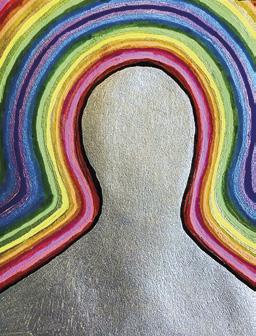

claudia pombo
Brazilian-Dutch painter Claudia Pombo offers an adapted view of nature and human situations. Her creative expressions include detailed illustrations of Amazonian mythology, metaphysical art, as well as colour-rich landscapes. The piece shown here, entitled Without Choice, reflects the artist's ruminations on current world events. www.clpombo.wordpress.com clpombo@gmail.com
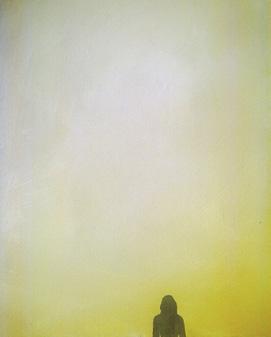
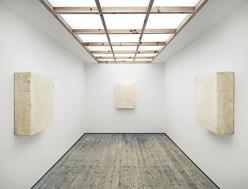

eleanor Bartlett
Eleanor Bartlett is an award-winning UK-based artist for whom material is paramount – she specialises in the use of tar and metal paint. "When you see a great lump of tar, it’s like looking at a fundamental building block of the universe." Textures and colours in solid forms inhabit both installations and paintings. Bartlett’s most recent solo show Tar and Wax: A Homage was at Three Works, Scarborough. www.eleanorbartlett.com

hannah Debson
Hannah Debson is a London-based fine art photographer who utilises light and colour to create evocative and stylised imagery. Portraiture, nude studies and still lifes are vehicles for exploration – Debson works to demystify the emotional and visual boundaries of beauty. Limited-edition, exhibition-quality prints are available to purchase directly from the artist. www.hannahdebson.com Instagram: @hannahdebson
Josh Hollingshead
Josh Hollingshead is an awardwinning artist whose work covers social, environmental, political and religious themes, as well as the occasional memento mori. His large-scale paintings demonstrate a vivid use of colour and precise details to elucidate a narrative. Hollingshead's works have been exhibited in London and Cambridge, and are on show at his UK studio gallery in Swanage, Dorset. www.joshhollingshead.net


Ori Gerard Frances
Ori Gerard Frances is a photographer and digital artist whose work has been widely exhibited. He believes the language of poetry and art is the only way to express certain aspects of our experience of reality in subtle and complex ways. Frances’s recent awards and honourable mentions include the Fine Art Photography Awards, Tokyo International Foto Awards and the IPA’s International Photography Awards. www.origerard.myportfolio.com








